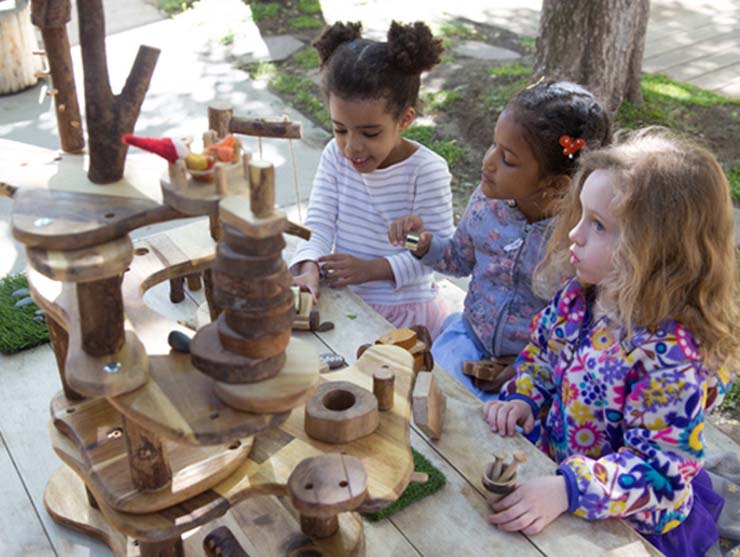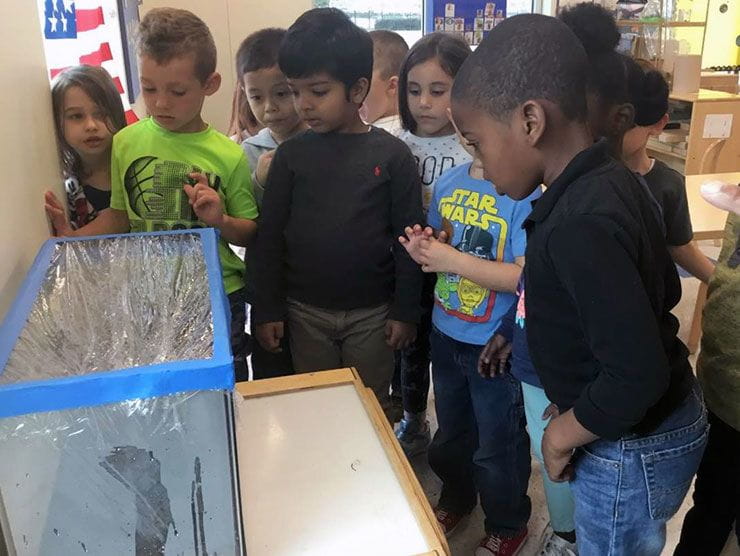We were recently joined by Anita Greenberg, CEO and founder of Science Delights for our Family Matters Webinar: A Parent’s Guide to STEM Education.
Along with webinar moderator Debbie Hoppy, Bright Horizons’ Director, Education & Curriculum, we explored the benefits of introducing STEM to your child early, activities, books, and games that can help, and how to use STEM to set your child up for future success. The webinar generated a lot of good discussion and some terrific questions from parents.
In today's post, Anita answers some of the questions that were top of mind for parents:
What is the earliest age to start building interest in STEM?
STEM can be integrated into everyday activities, at a very early age (infants even). As we’ve raised our daughter we have always used the accurate vocabulary when discussing everyday STEM concepts, even when our daughter has looked at us like we were crazy. We are listening to a podcast called “Science Solved It.” It’s a podcast written for adults that discusses breakthroughs in science that solved mysteries and urban legends. Each podcast is short (less than 20 minutes) and very engaging. We listen to them in the car and when my 8 year old doesn’t understand a word, or when I think she may be getting lost, I pause the podcast and ask her questions.
The podcast does not water down its vocabulary so I make sure to have these “check-in moments” with my daughter as we listen together. The most recent segment was about a cholera outbreak that occurred over 100 years ago, and Dr. John Snow, who while investigating the outbreak, developed what we now call epidemiology because of the way he tracked the outbreak. Not only did my daughter learn what the words “emanate” and “epidemiology” mean, but when we got home we were able to look up Dr. Snow’s map and see for ourselves how the outbreak had spread.
The podcast was engaging enough, even for my 8 year old, that she learned some new vocabulary, used primary sources, and learned about a scientific process that is still in use today. Using the accurate vocabulary builds prior knowledge that may not pay off until high school, but it will pay off. The prior knowledge becomes the glint of recognition as your child is sitting in a Biology or Earth Science class that can turn into excitement about the science, math, or technology.
Even if your child is an infant something as simple as the correct terminology or vocabulary can help years in the future. Accurate terminology creates prior knowledge. As your child gets older, as you continue to use the correct vocabulary and introduce them to more formal STEM concepts, deep connections will be made. If you and your child are playing with blocks, don’t use the term square (a 2-dimensional figure), use the term cube. When they enter elementary school and then move on to Geometry in high school and are introduced to 3-dimensional figures in a more formal environment, your use of accurate terminology will trigger the connection for them, allowing a deeper understanding of the concepts to occur more quickly.
Sometimes my 3 year old's attention span is short. How can we encourage him with STEM activities in a natural, organic way so that he stays interested? Instead of trying to add something new into the routine, incorporate STEM into what you are already doing. STEM can be wrapped around many different activities that your 3 year old does on a regular basis. For example:
- When he’s taking a bath, you can talk about buoyancy with his bath toys.
- If he likes collecting things outside (as my daughter does,) help him learn where they come from: leaves or seeds, what trees do they come from? Rocks, which is largest? Smallest? Heaviest?
- There are also “free play” toys that can help build his STEM skills. LEGOs and blocks are obvious choices, but kinetic sand, marble runs, and fort building are also amazing ways to build engineering skills.
We hear it's important to get girls involved with STEM. Should I be encouraging my daughter in a specific way?
Here is the wonderful thing about STEM: it is neutral. There is no natural way to discuss STEM in terms of girls activities, boy activities, activities for people of color, activities for the Jewish community, etc. Having said that, we all have biases that help us form opinions, expectations, and decisions. If your child—son or daughter—is interested in STEM and you are looking for a way to influence encourage their interest, always focus on what they, as individuals, are drawn to, are curious about, or are focused on.
Here are some examples:
- If your child enjoys doll houses or likes playing with stuffed animals, help them build their own! There are many products out there, like PlushCraft fabric. There are building kits that allow them to design and build their own play houses. Playing with blocks is another classic example of free, or open, play that is STEM oriented. With no set instructions the child can freely build, test out designs, fail and succeed, and learn from those failures and successes. Since there are lots of options, you can easily find one that fits your child’s skill level.
- If your son or daughter likes helping with cooking or baking, you can easily turn time spent in the kitchen into a math or science lesson. Baking, at its core, is chemistry. Discussions about leavening agents can turn into a discussion about acids and bases. As well, with any cooking and baking, recipe amounts can be multiplied or divided down.
- If your son or daughter is interested in cars and trains, integrating STEM into them is also natural. If your child is older (middle or high school,) get them involved in a traditional automotive class that some secondary schools offer.
- If your child is younger, building models of trains and cars can help teach about scale, and depending on the intricacy of the model, can teach about the cars and trains themselves. If you are close to a Formula 1 or NASCAR track, you can get into the garage and/or pits before and after races to look at the cars up close.
- Another great option is to use what’s available in your own backyard, so to speak. For example, my nephew is extremely interested in construction equipment and his parents have taken him to “touch a truck day” at local bases. They have also visited firehouses, and have stopped at local construction sites to watch the equipment work. Most of these things are available in towns and cities across the US.
About Anita:
Dr. Anita Greenberg has over 15 years of experience teaching children of all ages and designing and developing curriculum which has culminated in Science Delights. Science Delights involves early childhood and young elementary children in STEM activities and experiments. Children are introduced to STEM concepts, practice inquiry, and celebrate their ability to create. Each 30-45 minute activity focuses on a different concept that children explore. Dr. Greenberg earned her PhD in Curriculum and Instruction from The University of Texas at Austin. After teaching she worked with a number of educational publishing companies, leading development on 18 core products used in every state and winning six national awards.
RELATED RESOURCES:
- E-family news: STEM Activities for Preschool Children
- The Family Room: STEM Toys for Boys & Girls
- E-Family: STEM Resources & Activities for School-Age Children





